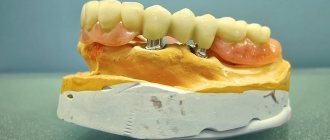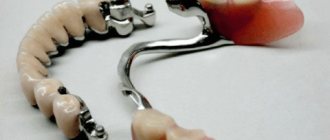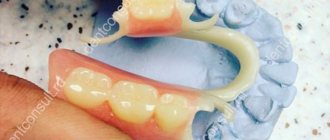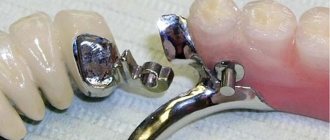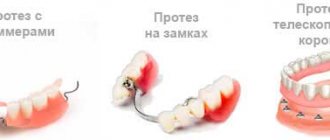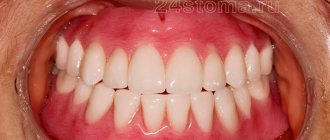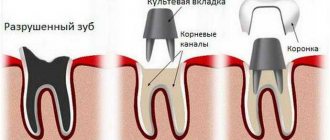From this article you will learn:
- what is clasp dental prosthetics?
- important features of these prostheses,
- clasp dentures – reviews, price 2021.
Clasp dentures are a type of removable dental prosthetics in dentistry, a characteristic feature of which is the presence of a metal arch (clasp) in the prosthesis. This arch gives the prosthesis special strength and can significantly reduce the volume and thickness of the base made of plastic or nylon. Thus, the prosthesis takes up significantly less space in the oral cavity and, for example, on the upper jaw it will no longer completely cover the palate.
Reviews of clasp dentures confirm that they are the most effective type of removable dental prosthetics. They are better than all other types of removable dentures - 1) they well compensate for lost chewing efficiency, 2) they are well fixed on the teeth, 3) they are comfortable when chewing and speaking, 4) they do not impair diction, 5) they have a long service life. These dentures can only be used in those patients who at least partially retain their own strong teeth, and these teeth should be on both sides of the jaw.
Clasp denture for the upper jaw:
Clinical case No. 1 –
The metal palatal arch on clasp dentures for the upper jaw can have an anterior, middle or posterior position, and can also be “ring-shaped”. In the latter case, the arc is located along the perimeter of the hard palate, leaving its central part open (see Fig. 11). The position of the arch is of great importance and depends on - 1) the number and location of missing teeth, 2) the relief of the palate, i.e. on the height of the vault of the palate and the severity of the torus, 3) the severity of the patient’s gag reflex.
In the absence of a gag reflex, the best option is certainly the posterior position of the arch (not reaching 4-5 mm from the border of the hard and soft palate). In this case, it does not interfere with the tongue, diction and the comfort of chewing food do not deteriorate, and taste sensations do not suffer. As we said above, the choice of arch position, as well as its width and thickness, do not depend on the patient’s choice, and are dictated by the situation in the oral cavity. But nevertheless, it is possible to reduce the size of the arch and the weight of the prosthesis if the metal frame is made not from the traditional cobalt-chromium alloy (CCH), but from titanium.
Planning the frame of the clasp denture for the upper jaw and the location of the support-retaining clasps (done on a plaster model of the patient’s teeth):
What to do if it breaks down
Although clasp dentures are extremely durable, they sometimes break. Statistics show that this problem occurs in 10% of patients. Failures of clasp prosthetic structures are different, and in each specific case different measures are required to repair them:
- if the prosthetic structure no longer fits tightly to the gum, relining is necessary, which is carried out within one to two days;
- if the cast frame breaks or the arch is fractured, it is necessary to make a new prosthetic structure;
- repair of cracks on the base is carried out promptly in the presence of the owner of the prosthesis;
- replacement of lost or worn teeth is carried out within one to two days;
- The clasp or lock is repaired within two days.
Please note that during the warranty period (most often its duration is one year), repairs are performed free of charge. If it is completed, you will have to pay for the repair.
Category Dentures Posted by admin
Clasp dentures for the lower jaw:
Below you can see examples of clasp dentures for the lower jaw (Fig. 4-6). Unlike numerous options for the position of the metal arch in dentures of the upper jaw, on the lower jaw the arch is always located in front (usually just below the front teeth, adjacent to the posterior surface of the alveolar process of the lower jaw).
Important: prosthetics with clasp dentures is possible - 1) only in case of partial absence of teeth, 2) your own teeth, which will be used to fix the prosthesis in the oral cavity, must be on both sides of the jaw. Otherwise, if you only have teeth on one side of the jaw, it will be fundamentally impossible to achieve good fixation of the prosthesis in the oral cavity. And in this case, you will need another prosthetic option.
How much does a clasp prosthesis cost?
The price of lower jaw prosthetics using a clasp design depends on the following factors:
- base and frame material;
- the number of teeth that need to be restored with a prosthesis;
- material for dental crowns.
The average price of a clasp prosthesis is from 32,000 rubles. The price, as a rule, already includes payment for the prosthesis itself, treatment planning, installation of the system, and check-ups with the dentist.
Clasp dentures are an inexpensive and accessible way to restore a smile with a long service life (more than 10 years).
Differences between clasp dentures and other types of dentures
As we said above, the main difference between this type of prosthesis and prostheses made of acrylic plastic and nylon is the presence of a metal frame (Fig. 2). Most often, the metal frame is made of cobalt-chromium alloy, titanium, or alloys with the addition of precious metals. A base, which can be made of pink plastic, nylon or Acry-free material, is welded onto the finished metal frame, and then artificial plastic teeth are fixed to the base.
Due to the presence of a metal frame, it is possible to significantly reduce the volume and thickness of the plastic base, and as a result, such a prosthesis takes up significantly less space in the oral cavity. Figures 7-8 show how clasp dentures differ in size from traditional dentures made of acrylic plastic. These differences are especially noticeable in the area of the front teeth and on the palate, where the clasp denture does not have a massive bridge, but only a thin metal arch.
Comparison of acrylic and clasp dentures –
Thus, a classic clasp prosthesis consists of - 1) a metal frame, 2) a base made of acrylic plastic or nylon into which artificial teeth will be installed, 3) a system for fixing the prosthesis to the supporting teeth. We will dwell on the latter in more detail below. But I would like to say a few more words about the options for the base of the prosthesis, which is traditionally made of pink acrylic plastic.
However, if the patient wishes, the base can also be made of either elastic nylon (which is not recommended) or Acry-Free material. Acri-free material is a new generation material, and unlike nylon, it has only a small degree of elasticity. Modern complete and partial removable dentures are made from this material, but the base of a clasp denture can also be made from it (though this will cost a little more).
Alternatives
Alternative options include:
- Elastic prosthetic structures Akri-Free are aesthetic, comfortable removable dentures, recommended for patients with complete edentia.
- New generation acrylic structures - diamond chips are added to acrylic plastic, which makes the orthopedic system more durable.
- Quadrotti is an arc structure (clasp) in which metal components are not used. Made from durable DENTAL D
, capable of withstanding high impact loads.
None of the listed removable structures are used for tooth mobility. Only clasp-type prostheses provide a splinting effect due to the cast frame. You need to know that removable prosthetics does not solve the problem of jawbone atrophy. Dental implantation will allow you to preserve its volume.
Article Expert
Alekperov Roman Borisovich Dentist-orthopedist, doctor of the highest category
Work experience: more than 31 years
Types of clasp dentures -
Patient reviews of clasp dentures are most often positive, and patients usually attribute only the insufficient aesthetics of the denture option with clasp fixation as a disadvantage (in some cases, metal clasps can be located in the smile line). Thus, reviews depend mainly on the chosen type of fixation of the prosthesis on the remaining teeth. There are the following options for fixing clasp dentures on abutment teeth:
- clasp dentures with clasps,
- clasp dentures with locks (attachments),
- clasp dentures on telescopic crowns.
Clasp dentures with clasps (video) –
Material used
The main material for the manufacture of the arch of clasp prosthetic structures is chromium-cobalt alloy. The arc of fastening of prosthetic structures with locks includes metal-ceramic crowns. A more expensive, and therefore less common, option is to use gold-platinum alloy instead of chromium-cobalt alloy, which does not cause allergies. In addition, there are metal-free clasp dentures, which use ceramics or extremely durable pressed plastic to make the arch. They are intended for patients suffering from metal allergies. These dentures are more fragile than metal ones, so they are at greater risk of damage and have a shorter lifespan.
Clasp dentures with clasps –
This is the simplest of the 3 types of clasp dentures, which nevertheless restores chewing function much better than any other removable dentures made of plastic or nylon. A design feature of this type of prosthesis is the presence of support-retaining clasps.
Functions of clasps –
- resistance to displacement of the prosthesis in vertical and all lateral directions,
- transmission of chewing pressure to the supporting teeth.
Clasp dentures: photo
Clasps are in most cases made of metal, and they are metal extensions extending from the cast metal frame of the prosthesis. However, if such clasps fall into the smile line, then they greatly spoil the aesthetics (Fig. 10). In this case, clasps located on the front surfaces of the teeth are sometimes made of more aesthetic and inconspicuous materials, for example, nylon (Fig. 11). But keep in mind that this will again increase the cost of the prosthesis.
Advantages of clasps with clasp fixation –
- excellent fixation of the prosthesis,
- Allows you to chew food effectively
- chewing is painless (unlike nylon dentures),
- the size of the prosthesis base is significantly smaller than that of prostheses made of plastic and nylon, which provides comfort when worn, does not impair diction, and does not cover the taste buds on the palate,
- ease of manufacture and, as a result, affordable cost (in comparison with other types of clasp dentures, as well as conditionally removable dentures).
Disadvantages of clasp dentures –
- Aesthetics may leave much to be desired (Fig. 12) - this is due to the fact that metal clasps in certain situations in the patient’s oral cavity can only be installed with their access to the front surface of the teeth, falling into the smile line. Moreover, not in all cases the clasps visible when smiling can be made of nylon, because this again can worsen the fixation of the prosthesis.
The possibility of hiding the clasps from the front surface of the teeth or making them less noticeable should be discussed with the doctor in advance during the consultation. In addition, a dental clinic may not even have a specialist capable of making dentures with such inconspicuous clasps.
- Partial destruction of supporting teeth - metal clasps of clasp dentures always have slight micro-mobility.
This is done specifically to give them a little elasticity, which is necessary for removing and putting on the prosthesis. But on the other hand, this leads to slight friction of the clasp on the tooth enamel during chewing, which in the long term leads to its gradual abrasion (24stoma.ru). That is why, in most cases, it is recommended to take abutment teeth to which the clasps will be fixed - under metal-ceramic crowns. Ceramics are resistant to friction from metal clasps, and then both the supporting teeth and the prosthesis itself will serve you for a very long time. True, in this case it will increase the cost of prosthetics by the cost of metal-ceramics.
- Higher cost - the price for clasp dentures will be higher than for traditional dentures made of acrylic plastic (the latter will cost about 20,000 to 30,000 rubles). And this is logical, because due to their higher manufacturing complexity, especially if the prosthesis uses a complex system of clasps. The cost of this type of prosthesis is approximately comparable to the cost of nylon prostheses.
Contraindications
Relative
the procedure can be carried out with extreme caution
- Inflammatory processes of the oral cavity.
Absolute
the procedure is strictly prohibited
- Severe atrophy of the jaw tissue;
- low supporting teeth or their absence;
- highly attached frenulum of the tongue;
- progressive periodontal diseases;
- deep bite;
- high abrasion of teeth;
- mental disorders that make it difficult to contact the patient;
- allergy to system components.
The success of dentures depends on proper planning of each stage of treatment and careful selection of the future dental structure.
Clasp dentures with locks (attachments) –
In addition to fixation with clasps, it is possible to manufacture clasp dentures with fixation using micro-locks (attachments). Half of each micro-lock is located on the clasp prosthesis itself, and the second half is on the supporting teeth, taken under metal-ceramic crowns (Fig. 13). When “putting on” the prosthesis, the micro-lock snaps into place, securely fixing the prosthesis to the supporting teeth.
Clasp dentures with locks: before and after photos
Clinical case No. 1 –
Clinical case No. 2 –
A very important point is the type of micro-locks!
In dental practice, micro-locks of the “MK-1” and “Bredent” types manufactured in Germany are mainly used. These locking mounts are considered the best, although there are cheaper analogues. Moreover, it is preferable to make MK-1, although it is more expensive. MK-1 is a deadbolt type lock, and Bredent is a friction type (i.e. uses friction force).
Without going into complex technical details: MK-1 is the best lock (its reliability and service life are higher than others). However, it cannot be used in all oral clinical situations. We recommend asking your doctor questions about the type of micro-locks, because... otherwise, you may end up with an expensive denture with cheap micro-locks that won't last long.
Clasp dentures with attachments (micro-locks): video
Advantages –
- excellent aesthetics (no clasps),
- good fixation of the prosthesis,
- comfortable, painless chewing (clasp dentures with locking fastenings ensure the transfer of 1/2 of the chewing load to the supporting teeth; this is a better indicator compared to other types of dentures that transfer the load mainly only to the gums, which leads to accelerated atrophy of the bone tissue under prosthesis).
- long service life (this period will be at least 5-7 years, which is a very long period by the standards of removable prosthetics; for example, plastic prostheses have an optimal service life of only 2.5 years).
Disadvantages of clasp dentures with locks –
- High cost (see below).
- It is necessary to take a lot of teeth for crowns - abutment teeth for a clasp denture with a locking type of fixation must be taken under metal-ceramic crowns, because lock fastenings can only be fixed on them. Usually a minimum of 4 crowns are made (two on each side of the dentition), but sometimes more are needed.
- The complexity of manufacturing - clasp dentures with locks - is one of the most high-tech designs in dental prosthetics today. Manufacturing requires very highly qualified orthopedists and dental technicians. Therefore, if you decide to make just such a prosthesis for yourself, then you probably shouldn’t look for a clinic with the lowest prices.
Price
The price of clasp prosthetics depends on the degree of complexity of the clinical case - the number of defects, their location, selected materials and manufacturing technology. Prices for prosthetics start from 50 thousand rubles.
The final cost of treatment is also influenced by the preparation and depulpation of supporting teeth for a crown, concomitant treatment of caries, gum and periodontal diseases, and bleaching for the optimal choice of shade of polymers.
You can find out how much a clasp prosthesis will cost in your particular case and ask any questions you have by consulting with an orthopedist in our clinic. Call to make an appointment at a time convenient for you. We'll be happy to help!
Clasp dentures on telescopic crowns –
This is probably the best option for clasp dentures, but also the most technically difficult to manufacture (requiring a very highly qualified dental technician) - even in comparison with clasp dentures with micro-locks. The essence of this type of prosthetics is that the supporting teeth are ground down, and then special metal caps are fixed on them. Such caps are the lower part of the so-called “telescopic crowns”.
In turn, the upper part of telescopic crowns (in the projection of the caps) is built into the body of the clasp prosthesis, which look like the most ordinary artificial crowns. When putting on a denture, the upper and lower parts of the telescopic crowns are combined, and this ensures an unprecedentedly reliable fixation. True, for really good fixation, it is necessary that the prosthesis be fixed on at least 4 telescopic crowns.
Clasp prosthesis on telescopic crowns:
This method of prosthetics ensures good fixation of the prosthesis, is completely invisible on the teeth (there are no metal clasps), and also perfectly distributes the chewing load - provided there is a sufficient number of telescopic crowns. As a result of the latter, bone tissue atrophy under the plastic base of the denture in the area of missing teeth occurs very slowly, and you will have to change your removable denture less often.
Below you can see a clinical example of the application of this technique. This is a difficult situation (terminal defects of the dentition) and the patient refused dental implantation. A non-ideal solution was chosen, because the prosthesis is fixed only on 2 telescopic crowns, which can certainly lead to a gradual overload of the supporting teeth. But in this example, the very principle of removable prosthetics with a clasp prosthesis on telescopic crowns is clearly visible.
Clinical case No. 3 –
Care products
Since clasp prosthetic structures are made of metal, they require special care. If the arc consists of several individual elements, the joints should not be machined to avoid darkening and staining. Cleaning should only be done with a soft brush. In general, caring for clasp dentures is similar to caring for other removable structures. Once a week they must be treated with a biological solution designed to remove food residues and stubborn stains. In general, the same products can be used to care for clasp dentures as for caring for other types of removable dentures. It is only important to ensure that these cleaning and disinfectants contain components that protect the metal base from the effects of corrosive processes. Once every six months, it is recommended to seek help from specialists for professional cleaning in order to remove plaque and hard deposits from clasp dentures.
Clasp dentures: price 2021
For clasp dentures, the cost will depend, first of all, on the type of fixation of the prosthesis to the supporting teeth, and secondly, on the material of the metal frame (it can be either a regular cobalt-chromium alloy or titanium). In addition, if you choose clasp prosthetics with micro-locks, then to the total cost of the prosthesis you will additionally need to add the cost of micro-locks, as well as the cost of metal-ceramic crowns.
When choosing a prosthesis with fixation using clasps, its cost will also depend on the complexity of manufacturing. In this regard, clasp dentures with clasp fixation are usually divided into simple and complex. Complex ones differ from simple ones in that they have a more complex system of clasps, and also in the fact that instead of one metal arc, there can be two of them.
1) The cost of a clasp denture with clasps –
The price for clasp prosthetics in economy class and mid-price segment clinics will be (taking into account the manufacture of a metal frame made of cobalt-chromium alloy):
- Simple clasp prosthesis - in Moscow from 40,000 rubles, in the regions - from 35,000 rubles,
- Complex clasp prosthesis - from 45,000 rubles in Moscow, in the regions - from 40,000 rubles.
- For splinting clasp dentures, prices in Moscow range from 45,000 to 55,000 rubles.
2) The cost of a prosthesis on telescopic crowns –
The option of a partial denture with fixation on telescopic crowns will cost you no less than 75,000 rubles, and the average price will be about 90,000 rubles (as a rule, this cost already includes the required number of telescopic crowns, but does not include preparing teeth for prosthetics). Remember that this version of the prosthesis requires a very highly qualified orthopedic dentist and dental technician, and therefore you should not choose a clinic with the lowest prices for this service.
3) Price of clasp dentures with micro-locks –
- A clasp prosthesis with fixation on 2 inexpensive micro-locks of economy class will cost in Moscow - from 70,000 rubles, and for the regions from 65,000 rubles. However, if prosthetics are performed using more expensive micro-locks such as “Bredent” or “MK-1” (the latter are considered the best in the world), then the cost of the prosthesis will be approximately another 20,000 rubles higher. The above prices include the cost of the prosthesis itself, the cost of micro-locks, but does not include the cost of metal-ceramic crowns and preparation of teeth for prosthetics.
- One-sided clasp prosthesis – from 50,000 rubles. This type of prosthesis is made when there is a unilateral defect in the dentition, when dental implantation is contraindicated, and it is impossible to manufacture a permanent bridge. The above price already includes the cost of the prosthesis itself and the cost of micro-locks (but excluding the cost of metal-ceramics).
4) Cost of clasp prostheses made of titanium –
- The cost of a simple clasp prosthesis with clasp fixation (no more than two clasps) in economy class clinics can start from 50,000 rubles. Complex versions of clasp prostheses made of titanium can cost in the range from 60,000 to 110,000 rubles.
Indications and contraindications for installing a clasp structure
The main indications for installing clasp dentures include:
- the presence of included and terminal defects of the dentition;
- unilateral defect;
- dental defects in the presence of periodontal disease.
Photo: dentalabor.ru Splinting clasp prosthesis (for moderate severity of periodontitis, an additional arch is installed only on the inside)
Contraindications:
- less than four supporting teeth;
- low crowns of the remaining teeth in the row;
- late stages of development of periodontal diseases.
Clasp prosthetics: patient reviews
Regarding clasp dental prosthetics, reviews from both patients and dentists are as positive as possible. Due to the fact that prostheses of this type are made on a cast metal frame, it is technically possible to reduce the base of the prosthesis, which makes the prosthesis as comfortable as possible for wearing, chewing and articulating speech.
- Convenience of wearing a prosthesis - prosthetics with clasp dentures of the lower jaw allows you to achieve greater freedom for the tongue, reduce diction disorders, and reduce the risk of the prosthesis falling out due to tongue movements.
All this is achieved by reducing the plastic base of the prosthesis in the sublingual area (Fig. 1). When replacing the upper jaw with dentures made of plastic or nylon, the entire palate on the patient’s upper jaw will be covered by the base of the prosthesis. If prosthetics is carried out using a clasp prosthesis, then the anterior part of the palate, which is responsible for diction and taste sensations, remains open (Fig. 2). - Do not worsen diction - the problem of poor diction after removable dentures usually arises due to the presence of a thick plastic base on the inside in the area of the front teeth on the lower and upper jaws. Thanks to the thin metal arch, clasp dentures do not have a plastic base in these areas, which allows you to maintain good diction.
- Comfortable chewing - the more chewing pressure is transferred from the denture to the gums, and not to the supporting teeth, the greater the discomfort and pain will be during chewing. Clasp dentures with clasps transfer approximately 1/3 of the chewing load to the supporting teeth, which is already a better indicator compared to dentures made of plastic or nylon. Clasp dentures with locking fastenings transfer approximately 1/2 of the chewing pressure to the supporting teeth and, accordingly, they will be the most comfortable for chewing.
- Long service life - the recommended service life for dentures with clasp fixation is 4-5 years, which is quite a long time by the standards of removable prosthetics.
For clasp dentures with locking fastenings, as well as with telescopic crowns, the service life should be at least 7 years (although the prosthesis may require relining of the plastic base). But ordinary removable dentures made of plastic are ideally recommended to be changed every 2-2.5 years. This is due to the fact that the tissues of the prosthetic bed (gums, bone tissue) under such dentures atrophy faster than under clasp dentures. Tissue atrophy leads to the fact that the tissues of the prosthetic bed gradually cease to correspond to the shape of the prosthesis, which over time leads to pain when wearing the prosthesis and deterioration of its fixation on the teeth.
- Good fixation in difficult situations - if locking fastenings are used in this type of prosthesis, this allows us to solve the problem of fixing the prosthesis in the most difficult situation in the oral cavity (in the presence of terminal defects of the dentition). Other types of prostheses in this case will necessarily balance and fall. In principle, in case of terminal defects, this is the only good option for fixing a removable denture, or another option is dental implantation.
- Reliability and strength – the risk of breakage of the clasp prosthesis is extremely low precisely due to the use of a solid metal frame. This cast frame is the basis of the prosthesis, and it is made of a durable cobalt-chromium alloy.
Alternatives to partial dentures –
Most experts clearly consider clasp dentures to be the best option for removable prosthetics in case of partial absence of teeth. However, the following partial dentures can be fabricated as an alternative:
- dentures made of acrylic plastic,
- Acry-Free dentures,
- nylon prostheses,
- conditionally removable dentures supported by several mini-implants (although this type of denture is most often used in the case of complete absence of teeth, in some cases it can still be made in case of partial absence of teeth, when a large group of teeth is missing in a row).
Advantages and disadvantages
For comparison, let’s take the clasp’s “classmates” - fixed bridges and removable plate prostheses. Clasp orthopedic structures, of course, are superior to plate ones in strength, but, like bridges, they are a temporary way to restore the dentition. Despite all the efforts of manufacturers, the clasp is not able to stop the loss of bone tissue, the inevitable decrease of which soon leads to changes in facial features and disturbances in the functioning of the dental system and internal organs. The obvious disadvantages of a removable clasp also include an aesthetic defect when installing a clasp prosthesis, when metal hooks attached to the teeth are visible, and a slow adaptation time to the design. In addition, any denture puts pressure on the gums and causes discomfort when chewing and hypoxia - a condition in which the gums do not have enough nutrition, which causes bone tissue to atrophy even faster. As for the service life of clasp dentures, compared to dental implants, it is quite short and is no more than 10 years. Subject to proper care and timely correction once a year.
What is important to pay attention to!
The most important part of the clasp prosthesis is its metal frame with a fixation system built into it. Initially, the frames of clasp dentures were made only by casting, for which a cobalt-chromium alloy (CCH) was used. Nowadays, the method of one-piece casting on a refractory model is still widely used, but more modern methods have now appeared that make it possible to increase the accuracy of the manufacture of this prosthesis in the dental laboratory.
For example, frames can be made using the modern method of “selective laser melting”, not only from CCS, but also from titanium. The use of titanium made it possible to both increase the strength of the metal frame (titanium is 5 times stronger than KHS) and reduce the weight of the clasp prosthesis by approximately 2 times. Reducing the weight of the prosthesis greatly facilitates getting used to it. Another modern method of manufacturing a metal frame for partial dentures, as well as caps for telescopic crowns, is milling on a computer-controlled machine (CAD/CAM technology).
You need to find out which method will be used to make your particular prosthesis during your initial consultation with your dentist. As a rule, small clinics that have their own dental laboratory do not have special milling equipment and a machine for selective laser melting (due to their high cost). We hope that our article: Clasp dentures reviews, price – was useful to you!
Sources:
1. Personal experience as a dentist, 2. “Orthopedic dentistry. Textbook" (Trezubov V.N.), 3. National Library of Medicine (USA), 4. https://www.realself.com/, 5. "Removable dentures: a textbook" (Mironova M.L.), 6 "Teeth restoration with clasp dentures (Fadeev R.A.).
